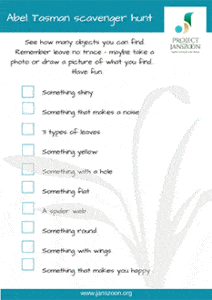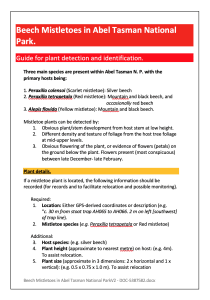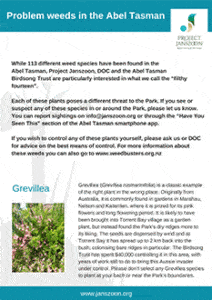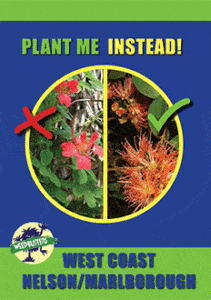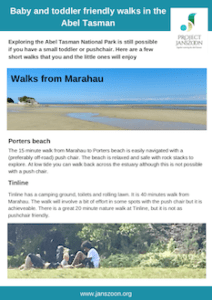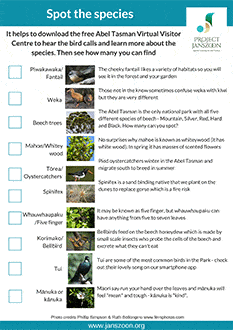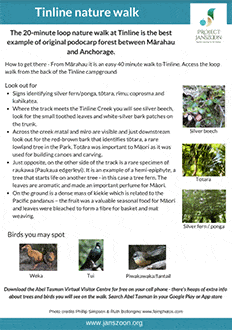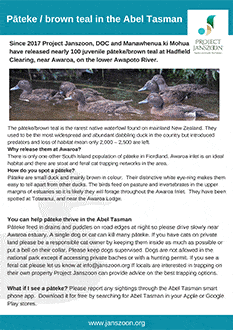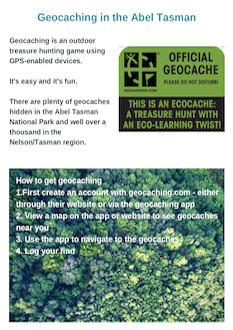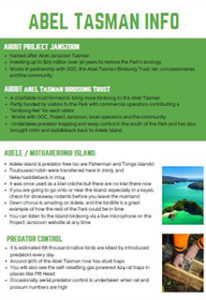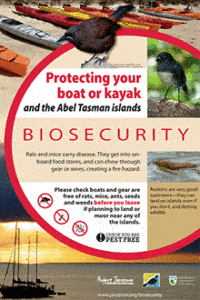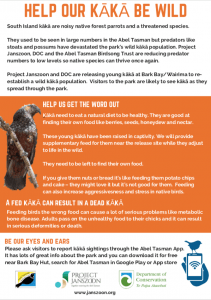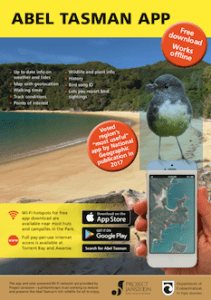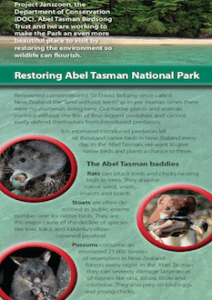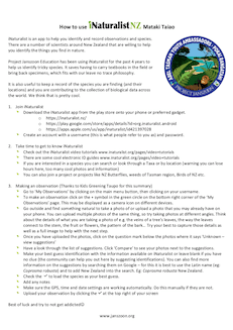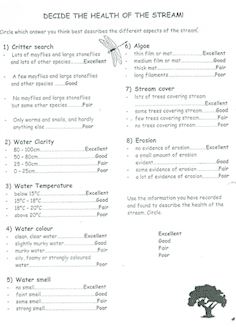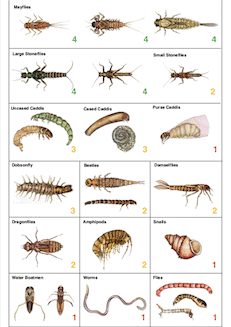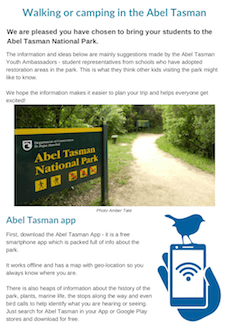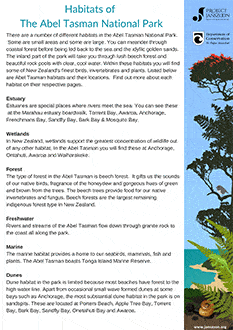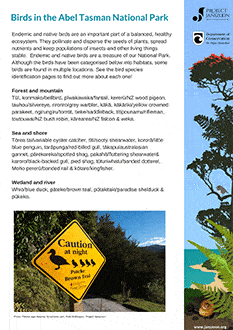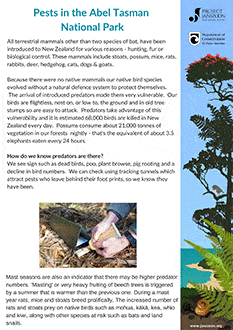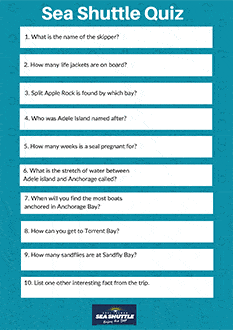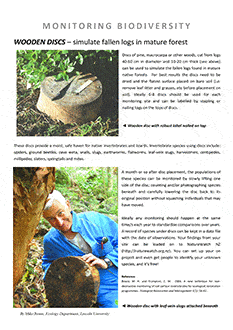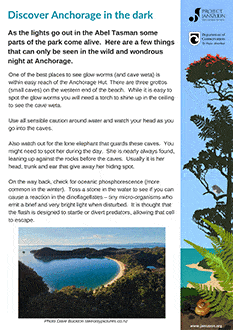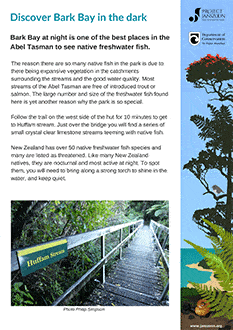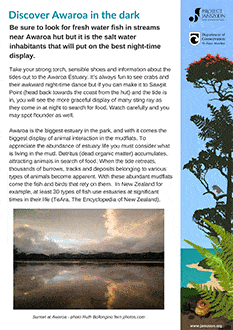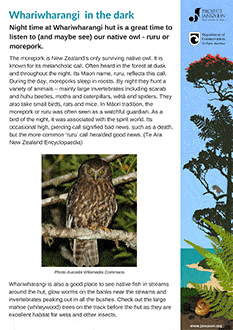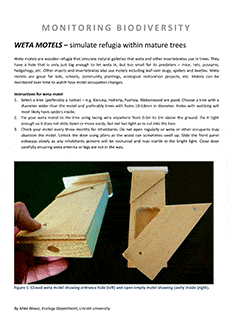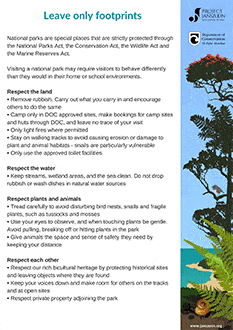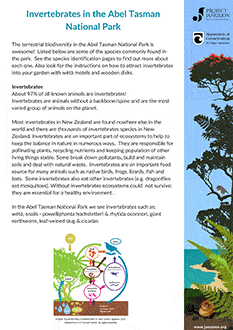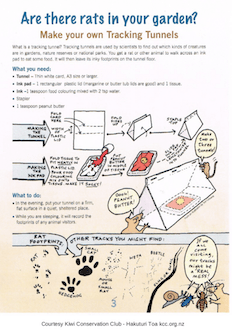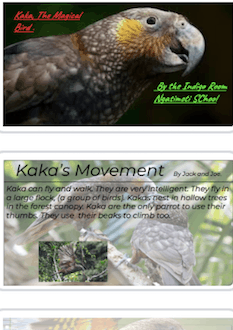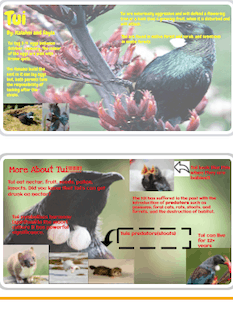RESOURCES
CASE STUDIES
A24 rat traps at Pitt Head
A case study on using A24 rat traps to keep rat numbers low – for good
wilding conifer control
A case study on cost effective control of dense wilding conifers in the Abel Tasman National Park
Acoustic monitoring of Forest Birds
A case study on the distribution of forest birds in the lowlands of the Abel Tasman National Park
Case studies: Monitoring endangered land snails in the ATNP
Three case studies on native snail monitoring methods and results in the Abel Tasman National Park

Scavenger hunt for the kids
A fun way to keep the kids occupied when they visit the Abel Tasman National Park
Mistletoe in the Abel Tasman
A guide from DOC ranger Steve Deverell to discovering mistletoe in the park.
Problem weeds in the Abel Tasman
A guide to recognising the fourteen main weeds in the park and how to get rid of them
Plant me instead
Wondering what are the best plants to grow in the Abel Tasman? Take a look at this
Easy walks with babies and toddlers
Recommended walks if you have a small toddler or push chair with you
Spot the species
Looking for something different to do in the park? See how many of these birds and trees you can spot
Tinline nature walk
A handy guide to this 20-minute walk around the best example of original podocarp forest between Marahau and Anchorage
Pāteke info sheet
If you spend time in Awaroa this information about protecting pāteke / brown teal ducks is very useful
Geocaching in the park
Geocaching is modern day treasure hunting and a fund way to spend time in the park
FOR OPERATORS
Either download and print or contact [email protected] for copies of posters and brochures
Abel Tasman info sheet
All you need to know about conservation initiatives currently underway in the Park.
Bio-security poster
A handy biosecurity guide for visitors kayaking to the park islands
Abel Tasman App poster
All the info your clients need about to load the Abel Tasman app.
Predator control info
The answers to all those questions about why we undertake predator control in the Park – in German, Mandarin and English.

How to use iNaturalist
A how-to guide for using the iNaturalist app to help you identify and record observations and species
Healthy stream checklist
A checklist that will help when you are monitoring the health of a stream.
Abel Tasman guide
A comprehensive guide for teachers taking students to the Abel Tasman prepared by our Abel Tasman Youth Ambassadors
Habitats in the Abel Tasman
A useful guide about the different habitats you will come across in the park and what makes them special.
Native birds in the Abel Tasman
Interesting facts about common native birds found in the Abel Tasman National Park
Pest animals in the Abel Tasman
A handy reference to the pest animals you may find in the Abel Tasman National Park and how they are being targeted
Sea Shuttle quiz
If you are traveling into the Park by Sea Shuttle this quiz is a great option to keep students on their toes
Wooden disks
A guide on how to set-up and use wooden discs to monitor soil surface invertebrates
Bark Bay by dark
Bark Bay is one of the best places in the park to see native fish – and they are most active at night
Awaroa by dark
When dusk comes to Awaroa it is the salt water inhabitants that put on the best night-time displays.
Whariwharangi at night
In the dark of Whariwharangi you can listen to (and maybe see) our native owl Morepork or ruru, and spot lots of invertebrates.
Leave only footprints
Visiting a national park may require visitors to behave differently than they would in their home or school environments – here’s a useful guide.
Invertebrates in the Abel Tasman
Information about some of the special invertebrates you may come across when visiting the Abel Tasman
All you need to know about kākā
The Indigo Room at Ngatimoti School have written this great guide about kākā
Tui in the park
Abel Tasman Youth Ambassadors Kalahni and Sayla’s from Ngatimoti School have written this guide on tui
Visiting the Park? Download our Abel Tasman app
The Abel Tasman App is a free smartphone app with up-to-date information on weather, tides, points of interest, history, plants, wildlife and walking times in Abel Tasman National Park. It has a map with geolocation – so you always know where you are!
SMARTPHONE RINGTONES
If you would like to enjoy a little bit of the Abel Tasman National Park’s birdlife every day then download these ringtones we have sourced from the birds on Motuareronui Adele Island.
For Android™ and other devices:
For Android:
1. Download the sound file (right-click the link and Save as)
2. Go to Settings > Sound > Device ringtone. You will see a list of the phone’s default ringtones
3. Tap the Add button to launch the media manager app
4. You will see a list of music files stored on your phone. Select one and tap Done
For iPhone:
1. Download the sound file
2. In iTunes, go to Tones section, click on File – Add File to Library (to add the .m4r file to iTunes)
3. Then sync it to iPhone as a ringtone
4. Then change your ringtone through settings – sounds – ringtone

